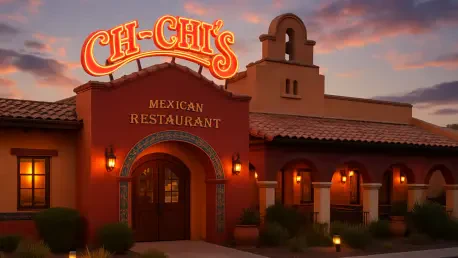In an era where dining trends shift rapidly, the return of a beloved name from the past can stir powerful emotions and curiosity among food enthusiasts across the nation, and Chi-Chi’s, a casual-dining Mexican restaurant chain that once introduced countless Americans to flavors south of the border, has made a striking comeback with its first reopening since 2004 in St. Louis Park, a suburb of Minneapolis. This revival isn’t just about rekindling old memories; it’s a calculated blend of nostalgia and modern culinary innovation designed to capture the hearts of both loyal fans and a new generation of diners. Under the leadership of Michael McDermott, son of co-founder Marno McDermott, the brand aims to reclaim its place in the competitive dining landscape. With a storied history that spans from its founding in 1975 to a challenging closure two decades ago, the journey of this iconic chain offers a fascinating glimpse into how heritage and adaptation can intersect to create something fresh yet familiar in today’s market.
A Storied Past and a Bold New Beginning
The history of Chi-Chi’s is a tale of both triumph and tribulation, reflecting the highs and lows of the restaurant industry over nearly five decades. Founded in Minneapolis, the chain grew to around 200 locations at its peak, becoming a household name for Mexican cuisine in the United States. However, financial struggles leading to bankruptcy in 2003, coupled with a devastating health crisis linked to a hepatitis A outbreak that same year, forced the closure of all U.S. locations by 2004. The incident, tied to contaminated green onions, affected hundreds and left a lasting scar on the brand’s reputation. Now, with Michael McDermott at the helm and a partnership with Hormel Foods, which owns the brand name, Chi-Chi’s is stepping back into the spotlight. The new location at 1602 West End Blvd. in St. Louis Park, previously home to McDermott’s Rojo Mexican Grill, serves as a testing ground for this ambitious relaunch, aiming to rebuild trust while honoring the legacy of festive dining that defined the chain’s early success.
This revival isn’t merely a replica of the past but a thoughtful reinvention tailored to contemporary tastes and expectations. The St. Louis Park restaurant introduces a modern aesthetic paired with a menu that balances classic dishes like chimichangas and deep-fried ice cream with innovative offerings such as quesabirria tacos, reflecting current food trends. A prominent bar boasting over 100 tequilas caters to a growing interest in craft spirits, while main dishes priced between $15 and $24 aim to position the restaurant as an accessible yet upscale casual dining option. Beyond the food and ambiance, the relaunch carries an emotional weight, seeking to recapture the “food, energy, and fun” that Michael McDermott associates with the original Chi-Chi’s experience. This blend of nostalgia with forward-thinking updates signals a broader strategy to appeal across generations, acknowledging that while fond memories can draw customers in, it’s the quality and relevance of the current offering that will keep them coming back for more.
Strategic Growth and Community Engagement
Looking beyond the initial reopening, Chi-Chi’s has outlined an ambitious roadmap for expansion that hinges on both strategic planning and public support. The goal is to establish two locations in Minnesota before exploring franchising opportunities to scale the brand further. This cautious yet optimistic approach reflects an understanding of the challenges inherent in reintroducing a name tied to past controversies into a crowded market. To fuel this growth, a crowdfunding campaign targeting $3.5 million has already raised an impressive $2.4 million, showcasing significant community interest and investment in the brand’s return. This funding model taps into a growing trend of direct consumer involvement in brand revivals, where nostalgia plays a key role in rallying support. By engaging the public in this way, Chi-Chi’s not only secures financial backing but also builds a sense of ownership among its future patrons, potentially fostering a loyal customer base from the outset.
The emphasis on community extends to how Chi-Chi’s positions itself within the local dining scene, aiming to be more than just a restaurant but a cultural touchstone once again. The focus on Minnesota as the starting point for this revival is no accident; it’s a return to the chain’s roots, where it first captured the imagination of diners in the 1970s. This localized strategy allows for a deeper connection with a demographic that may still hold fond memories of family dinners and celebrations at Chi-Chi’s. Moreover, the crowdfunding success suggests a readiness among consumers to embrace brands with historical significance, provided they adapt to modern expectations. Yet, the path forward isn’t without hurdles, as the full-service Mexican dining segment faces sluggish growth and intense competition. The ability to translate early enthusiasm into sustained business will depend on maintaining quality, innovation, and a narrative that resonates with both past patrons and those encountering the brand for the first time.
Navigating a Competitive and Challenging Market
Despite the excitement surrounding Chi-Chi’s return, the full-service Mexican restaurant sector presents formidable challenges that could temper expectations. Recent industry data indicates that sales growth in this category has been minimal, lagging behind the broader full-service dining average. This sluggish performance is compounded by the struggles of competitors, with several established chains filing for bankruptcy in recent times, highlighting the financial risks inherent in this space. For Chi-Chi’s, reentering this market means confronting not only economic headwinds but also the lingering shadow of its past health crisis, which could affect consumer trust. While nostalgia can be a powerful draw, it alone may not suffice in a landscape where diners prioritize safety, value, and unique experiences over brand familiarity, requiring a meticulous approach to rebuild credibility.
Compounding these challenges is the broader trend of nostalgia-driven revivals among other defunct restaurant brands attempting comebacks, each vying for a share of consumer attention in a saturated industry. Chi-Chi’s must differentiate itself by leveraging its modernized menu and design while addressing historical baggage head-on through transparency and rigorous safety standards. Success in this environment will hinge on the ability to adapt to shifting consumer preferences, such as a growing demand for authentic flavors and sustainable practices, which weren’t as prominent during the chain’s original run. The competitive pressures underscore the reality that while the emotional pull of the past can open doors, it’s the execution of a contemporary vision that will determine long-term viability. As Chi-Chi’s navigates this delicate balance, its journey offers a case study in whether heritage can coexist with innovation in a market that’s both unforgiving and ever-evolving.
Reflecting on a Legacy Reimagined
Looking back, the relaunch of Chi-Chi’s in St. Louis Park marked a pivotal moment for a brand that had once been a cornerstone of casual Mexican dining in America. The effort to blend cherished traditions with modern flair captured attention, as did the strategic use of crowdfunding to rally community support for the venture. Challenges from a tough market and past controversies loomed large, yet the initial steps showed a commitment to overcoming them with thoughtful updates and a return to the chain’s Minnesota roots. For those who remembered the vibrant atmosphere of the original locations, this revival stirred a sense of hope mingled with curiosity about what lay ahead. Moving forward, the focus should rest on sustaining momentum through consistent quality, engaging storytelling, and perhaps most critically, listening to diner feedback to refine the experience. As other nostalgic brands also attempt comebacks, Chi-Chi’s stands as a reminder that while the past can inspire, the future demands adaptability and resilience to truly thrive.









